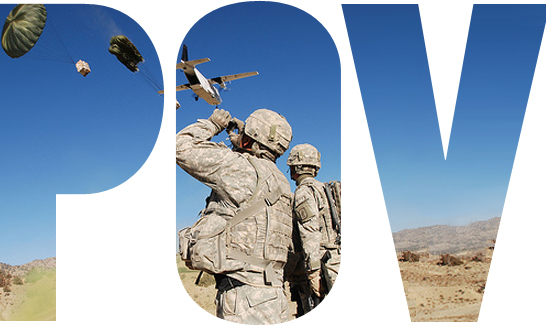POV: US Military’s Plummeting Collateral Damage
Something to cheer about this Veterans Day: declining civilian deaths in Afghanistan

Photo courtesy of the US Army
“POV” is an opinion page that provides timely commentaries from students, faculty, and staff on a variety of issues: on-campus, local, state, national, or international. Anyone interested in submitting a piece, which should be about 700 words long, should contact Rich Barlow at barlowr@bu.edu.
Last month, in the week before the 12th anniversary of the start of the war in Afghanistan, four US soldiers were killed, a stiff reminder, if one were needed, of the human toll of US fighting there.
Many assessments of the war and occupation of Afghanistan are negative, highlighting continued fighting, ongoing corruption, and the occasional G.I. who goes berserk, killing civilians. But something rather amazing also has occurred and deserves attention and credit.
Over the past few years, US military and civilian leaders learned not only that civilian protection in a war zone is important, but also began to systematically protect civilians. And they achieved results.
At the war’s start, some leaders minimized the importance of Afghan civilians. General Tommy Franks said, “We don’t do body counts.” Senator John McCain (R-Ariz.) said, “…civilian casualties, however regrettable and however tragic…have to be secondary to the primary goal of eliminating the enemy.” Former defense secretary Donald Rumsfeld declared that civilian casualties were inevitable: “Now in a war, that happens. There is nothing you can do about it.”
While the United States began the war promising to keep civilian casualties low and made some effort to avoid incidents of large-scale harm to civilians, in practice, the military necessity (killing militants) was prioritized over civilian protection. By my own conservative estimate, based on publicly available sources, some 20,000 Afghan civilians have been killed since 2001. We and our allies are responsible for about a quarter of those deaths.
Incidents ranged from the unbelievable—the United States twice bombing the same clearly marked Red Cross building in 2001—to the spectacularly awful—American bombs killing more than 90 civilians, including 60 children, in Azizabad in August 2008 in the effort to kill one militant leader. More common were incidents when handfuls of civilians were killed during air support or night raid missions.
Meantime, Americans developed an unfortunate habit of initially disputing or denying Afghan death and injury tolls, only to later acknowledge and apologize for the harm.
But this is a good news story. The US military and civilian leadership eventually learned that killing civilians not only damages the image of Americans abroad, but also causes an uptick in militant activity. In other words, when the United States or its allies hurt or killed civilians, and then failed to acknowledge the harm, our soldiers were at greater risk. Protecting civilians, therefore, became a military necessity.
In 2008, General David McKiernan, then US commander in Afghanistan, reversed previous policy and created the Civilian Casualty Tracking Cell to investigate instances of harm to civilians and gather the data that would make it possible to analyze trends. A Defense Department report in January 2009 stated, in typical Pentagon jargon, “Kinetic operations have to be carefully executed to avoid civilian casualties and collateral damage that weaken popular support for international forces.”
McKiernan and his successors (Generals Stanley McChrystal and David Petraeus) made significant changes in the rules of engagement and tactics in an effort to reduce the likelihood of harm to civilians. The most important was the 2009 institutionalization of restrictions on air strikes. Further, US officials began to acknowledge and apologize for harming civilians and stopped blaming Afghans civilians for being in the way. By early 2012, the stated goal in Afghanistan was “zero” collateral damage deaths.
So while military actions still kill and injure Afghan civilians, the United States and its partners have increasingly taken greater care to avoid such harm. They have come to view collateral damage “accidents” as both predictable and preventable.
Overall, the United Nations has found that the percentage of civilians killed by US-led international and Afghan forces has declined—to 11 percent in 2012 from a high of 41 percent in 2007—even as the intensity of the fighting increased. Moreover, the US military has changed policy in Afghanistan and institutionalized greater care for civilians in upgraded Air Force targeting procedures and new Army manuals and training.
US procedures for drone strikes, however, have been slower to evolve. Although the numbers are hotly disputed, the United States has apparently killed hundreds if not thousands of civilians in its attempts to target militants in Pakistan and Yemen. Only in May of this year did President Obama articulate what might be called a “zero-tolerance” for civilian casualties in drone strikes: “Before any strike is taken, there must be near-certainty that no civilian can be killed or injured—the highest standard we can set.”
Yes, we should take time now for somber reflection on the US war in Afghanistan. But, in fairness, we also must credit policy makers for learning from mistakes.
Neta Crawford, a College of Arts & Sciences professor of political science, can be reached at crawfor@bu.edu. This column originally appeared in Cognoscenti, WBUR’s online opinion page.
“POV” is an opinion page that provides timely commentaries from students, faculty, and staff on a variety of issues: on-campus, local, state, national, or international. Anyone interested in submitting a piece, which should be about 700 words long, should contact Rich Barlow at barlowr@bu.edu. BU Today reserves the right to reject or edit submissions. The views expressed are solely those of the author and are not intended to represent the views of Boston University.
Comments & Discussion
Boston University moderates comments to facilitate an informed, substantive, civil conversation. Abusive, profane, self-promotional, misleading, incoherent or off-topic comments will be rejected. Moderators are staffed during regular business hours (EST) and can only accept comments written in English. Statistics or facts must include a citation or a link to the citation.